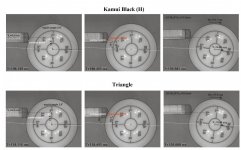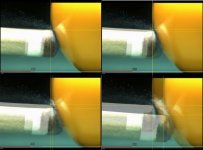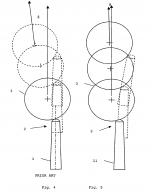You are using an out of date browser. It may not display this or other websites correctly.
You should upgrade or use an alternative browser.
You should upgrade or use an alternative browser.
Stroke: Follow Through
- Thread starter justnum
- Start date
For the record, creating a thread on follow through on AZBilliards is just as bad as going into a music shop and playing Stairway to Heaven on one of the guitars.
It's an unwritten rule that everybody knows. You just don't do it.
Green for you bro...the stairway bit killed me!
I thought it be possible to perform less traditional shots using abnormal contact time strokes.
The numbers helped me gauged how abnormal they can get.
English! couldn't bring himself to post this himself? lol
We've talked about it before. Adjustments made "during the duration of contact" are all but impossible. And even if they weren't, why even risk trying?
We can argue all day about "how long" the contact might actually last, but at the end of the day, you're not going to execute a specific motion to adjust the movement of the cue ball only "during" contact.
Bang away!...but you still can't beat physics! The CB leaves the tip in about a quarter of the time it takes to reflexively blink your eye (.004 seconds). Nothing can dramatically alter that miniscule dwell time (001-.002 seconds)...including exaggerated followthrough.
Scott Lee
http://poolknowledge.com
Scott Lee
http://poolknowledge.com
I just wanted to discuss the idea of cue ball control, in terms of using the spin speed to influence the object ball path
The science of banging
Last edited:
How long can contact with the cueball last during a stroke?
Sometimes on a long shot, it feels like my stroke last 3 diamond lengths.
Is that a legal shot?
I aim on the shot, know I will need power and just whale it. To me it feels like my cue stick is driving the cueball for a while on those.
Depends:
Stiffness of the shaft
Tightness of the bridge - closed vs open
Tight or loose grip - forcing the push vs throwing the cue without gripping
Hardness or softness of the tip - hard recovers compression faster than a soft tip
All in all a couple of milliseconds.


Last edited:
I watched the whole swoop stroke video
http://billiards.colostate.edu/threads/stroke.html#staying
Thats not what I am talking about.
The video only covered its effect from one distance.
I think I am talking about cut shots, like if you spin the cue ball left, the object ball spins right after contact. I checked the website for cut shot info.
So If I apply a strong left spin on the cueball, how much distance off the line will the object ball actually get after the collision.
You are asking if it is possible to increase contact time with the cueball in order to achieve... well I'm not sure what you are trying to achieve. Same exact concept the swoop stroke proponents are preaching.
The above question about cut shots and throw isn't even remotely close to the first question you asked.
English will throw an object ball, tip contact doesn't have much to do with that other than applying the spin and momentum to the cue ball. You are not going to achieve freakish amounts of throw by using some magic stroke that somehow breaks the laws of physics.
An answer to your question of how much will it throw, go to a table and spin the hell out of the balls and take notes, that's the only true way to learn it. All the math in the world won't help you figure it out, as it will change vastly with the differences in equipment and strokes.
None of this was meant to be harsh, I just think your allowing your imagination to derail your rational thinking.
You are asking if it is possible to increase contact time with the cueball in order to achieve... well I'm not sure what you are trying to achieve. Same exact concept the swoop stroke proponents are preaching.
The above question about cut shots and throw isn't even remotely close to the first question you asked.
English will throw an object ball, tip contact doesn't have much to do with that other than applying the spin and momentum to the cue ball. You are not going to achieve freakish amounts of throw by using some magic stroke that somehow breaks the laws of physics.
An answer to your question of how much will it throw, go to a table and spin the hell out of the balls and take notes, that's the only true way to learn it. All the math in the world won't help you figure it out, as it will change vastly with the differences in equipment and strokes.
None of this was meant to be harsh, I just think your allowing your imagination to derail your rational thinking.
Contact time was a side topic.
Now I know what I wanted to say.
Speed stroking is what I wanted to discuss.
Stroking the cue hard and fast versus soft and gentle.
I have the WPA handbook, which discusses the diamond system and some English. But little is mentioned about speed stroking.
Is speed stroking a real thing?
Does a fast and hard stroke produce intended effects on the object ball?
Does a slow and gentle stroke have any noticeable worthwhile effects on the object ball?
I wasn't sure if it was covered and AZ has the best language to describe cue stick actions.
Contact time was a side topic.
Now I know what I wanted to say.
Speed stroking is what I wanted to discuss.
Stroking the cue hard and fast versus soft and gentle.
I have the WPA handbook, which discusses the diamond system and some English. But little is mentioned about speed stroking.
Is speed stroking a real thing?
Does a fast and hard stroke produce intended effects on the object ball?
Does a slow and gentle stroke have any noticeable worthwhile effects on the object ball?
I wasn't sure if it was covered and AZ has the best language to describe cue stick actions.
A fast and hard stroke makes the object ball move at a slower speed (half the rpm if my calculations are correct) and the opposite is true with a slow and gentle stroke (the object balls rpms double).
A fast and hard stroke makes the object ball move at a slower speed (half the rpm if my calculations are correct) and the opposite is true with a slow and gentle stroke (the object balls rpms double).
How would you factor in contact displacement?
On a hard and fast stroke contact displacement has to be higher than a slow and gentle stroke.
What is hard to determine is the range of contact displacement? How much the object ball path curves or shifts off the line because of the different strokes?
How would you factor in contact displacement?
On a hard and fast stroke contact displacement has to be higher than a slow and gentle stroke.
What is hard to determine is the range of contact displacement? How much the object ball path curves or shifts off the line because of the different strokes?
Well for starters there are a variety of convoluted factors. The displacement of the tip depends upon not only on how hard and fast the stroke is, but how fast and hard it is as well. You see, if ignore certain variables and agree that the friction of the cloth is n=xs1/2 then I think you'll agree the object ball shifts 1/2" off line when using a hard and fast stroke but a whopping 5/10" off line when using a fast and hard stroke.
Hope that helps!
A hard stroke my result in more squirt.
View attachment 440803
That was not the picture I was expecting.
The mass in the last 6-9" of the cue and the contact point off center of the vertical line of the cb determine the amount of squirt. (the amount the cb goes off the shot line). Speed comes into play with swerve. (the amount the cb will curve and the distance away from initial contact that it does begin to curve.)
if you can get enough wrist snap into your hard stroke , enough that you accelerate at the speed the cue ball is accelerating plus the rebound off the tip you can keep your cue tip on the cue ball for as long as you want and steer the cue ball anywhere you want it to go for the length of your stroke.
so justnum you are right and all these people have no idea of what they are talking about.
so justnum you are right and all these people have no idea of what they are talking about.
if you can get enough wrist snap into your hard stroke , enough that you accelerate at the speed the cue ball is accelerating plus the rebound off the tip you can keep your cue tip on the cue ball for as long as you want and steer the cue ball anywhere you want it to go for the length of your stroke.
so justnum you are right and all these people have no idea of what they are talking about.
No you can't.
The very instant (fractions of a millisecond) your tip touches that cue ball, it leaves your tip. Nothing is going to have an effect on the cue ball after that point and if it does, it is the result of a double-hit, thus a foul.
You trying to redefine physics with your silliness, isn't going to change that either.
Last edited:
No you can't.
The very instant (fractions of a millisecond) your tip touches that cue ball, it leaves your tip. Nothing is going to have an effect on the cue ball after that point and if it does, it is the result of a double-hit, thus a foul.
You trying to redefine physics with your silliness, isn't going to change that either.
Yes with a hard and fast stroke, but stroking fast and hard will result in increased tip to ball contact time. Approximately 1 to 2 seconds depending on the tip. It helps if you squueze right before impact. It helps if you're already a runout player.
Fixed that for you Jon. 
Scott Lee
http://poolknowledge.com
Scott Lee
http://poolknowledge.com
Yes with a hard and fast stroke, but stroking fast and hard will result in increased tip to ball contact time. Approximately 1 to 2 milliseconds depending on the tip. It helps if you squueze right before impact. It helps if you're already a runout player.
You forgot the smilie. :grin-square::grin::grin-square::grin::wink:if you can get enough wrist snap into your hard stroke , enough that you accelerate at the speed the cue ball is accelerating plus the rebound off the tip you can keep your cue tip on the cue ball for as long as you want and steer the cue ball anywhere you want it to go for the length of your stroke. ... .
The Puritans banned bear baiting not due to the cruelty to the bear but to prevent the pleasure of the people.

Yes with a hard and fast stroke, but stroking fast and hard will result in increased tip to ball contact time. Approximately 1 to 2 seconds depending on the tip. It helps if you squueze right before impact. It helps if you're already a runout player.
You can't as a human being do anything that requires muscular movement within the 1 to 2 milliseconds of time that the tip will be in contact with the cue ball. Hard tip, soft tip, fast stroke, slow stroke. None of it is going to make a difference.
So however it is that you are hitting it from the very start of your stroke to the very moment that it makes contact is going to be the only affect you have on that cue ball.
Twisting your wrist, swinging out the cue or whatever physical thing you try to do at contact to change the movement of the ball is simply not going to happen because you can't possibly do it fast enough.
